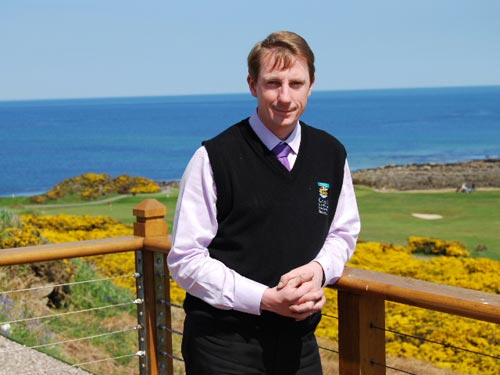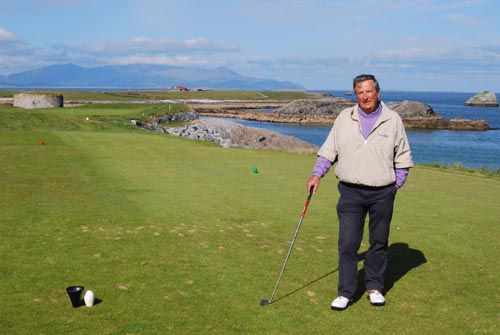Golf Tourism: Lessons from abroad

The British Open, which begins today in St. Andrews, Scotland, provides the impetus for a discussion on golf tourism and lessons that Hawaii can learn about developing itself as a golfer’s destination. Northern Ireland’s Rory McIlroy, above, hit his tee shot on the 18th hole during a practice round yesterday on the Old Course at St. Andrews.

David Roy, managing director of the Crail Golfing Society near St. Andrews, finds that golfers from the European continent won’t tackle Scotland’s courses until they’re satisfied they’ve reached “a certain level of ability.”

Pierce Wall, CEO of Ireland Golf, at Tralee Golf Club, says that television and an off-the-cuff remark by Tom Watson have helped increase the numbers of golfing tourists coming to the Emerald Isle.



Much has been said, and much fretting done, about Hawaii tapping new veins of tourism, the lifeblood of the state’s ailing economy.
Gov. Linda Lingle spent two weeks in China and Japan last month to encourage tourism and other opportunities for the state. Hawaii, like other tourist destinations in many corners of the planet, is eyeing the new affluence of China. But unlike other global locales, Hawaii has taken scant notice of an emerging niche market — one for which it would seem a natural, with yearround balmy weather, blue skies and picturesque lands: Golf tourism.
WHO PLAYS GOLF HERESome facts about golf tourism in Hawaii: » About 12.5 percent of out-of-state visitors to Hawaii or interisland travelers play one or two times, amounting to 945,857 golf-related trips.
|
China itself is recognizing its citizens’ growing attraction to the sport: A weeklong Sino-U.S. Golf Tourism Expo will be held in September in Shanghai, Beijing and Chengdu to promote outbound golf tourism from China and showcase U.S. golf destinations.
Don't miss out on what's happening!
Stay in touch with breaking news, as it happens, conveniently in your email inbox. It's FREE!
Scotland — home to the British Open, which tees off today — is similarly interested. Graeme Pook, a Scottish golf tourism travel planner, returned home this week after joining Scotland’s first minister at a Shanghai expo encouraging increased economic activity. Pook said his new golf program for bringing Chinese golfers to Scotland has the support of the Chinese government.
China is flourishing with golf courses, but visa requirements are an impediment to new golfers taking their clubs abroad, according to golf industry officials. Meanwhile, Hawaii will continue its dependency on the U.S. mainland and Canada for most of its golf tourists. Opportunity, though, awaits.
Golf-related tourism spending in Hawaii totaled $441.7 million in 2007, according to a study last year by SRI International. Globally, the International Association of Golfing Tour Operators says the golf tourism market is $17 billion, and growing.
China’s first golf courses were built in 1984. The number of courses now is estimated at 300, and 22 courses are included in a project to turn part of Hainan, China’s southern island province, into its version of Hawaii. The China Golf Association estimates China’s golfing population at 3 million and predicts it will number 20 million, nearing the 28 million U.S. golfers, by 2020.
In addition, the industry has recognized emerging golf tourist destinations in the Czech Republic, Vietnam, Indonesia and Kenya.

Clearly, competition is increasing, and Hawaii should prepare, said Mark Rolfing, longtime host of "Golf Hawaii" on the Golf Channel and adviser to the Hawaii Tourism Authority, whose half-hour NBC program, "Global Golf Adventure," is scheduled to debut on July 31. He says golf today too often "costs too much and takes too long to play. That’s inherent to Hawaii in particular."
Unlike decades ago, most major hotels and resort golf courses in Hawaii are separately owned, and hotels don’t want their guests to play golf, Rolfing said. "They’d rather have people stay within their hotel activity centers and taking the time to do the other activities that they either own or more closely control to make money off."
Rolfing says golf in Hawaii is too difficult for newcomers to the game, "particularly if you’re looking at a market like China, where they are going to be novices. You’ve got to make sure that they can come here and enjoy themselves by playing some decent golf."
Similarly, the golf industry is "quite immature" on the European continent, so parties of German or Swiss golfers "go every year to Portugal, Spain or Turkey, and they’ll be doing that for years before they’ll consider a trip to Scotland," said David Roy, managing secretary of the Balcomie and Craigshead Links’ Crail Golfing Society near St. Andrews. "They feel that the courses are a lot more challenging. They want to do the course justice when they come here, so they feel that they have to have a certain level of ability."
Roy is satisfied with those golfers’ present choices: "We don’t suffer the 5 1/2 – or six-hour events normally that you’ll see is common in the inside of Spain, and I think that’s a very clear indication that we’re getting a different type of golfer." A normal round takes four hours.
A key component of successful golf tourism has been television exposure, such as this week’s British Open at Scotland’s St. Andrews Links. Thirty years ago when Jack Nicklaus arrived at St. Andrews by train, "he looked at it and thought it was like a goat patch, and he didn’t realize it was actually a golf course," said Mike Woodcock, communications manager of St. Andrews Links Trust.
Ireland experienced a rush of golf tourism in 1982, when Tom Watson, after accepting the Claret Jug at Scotland’s Royal Troon, mentioned on television, "Nobody can call himself a golfer until he has played at Ballybunion; you would think the game originated there."
For years, Watson had been practicing at the Ballybunion course at the mouth of the Shannon River in southwestern Ireland in days leading to the British Open.
"That one statement put the Southwest on the map, and then we started to get fairly well-to-do Americans coming," said Pierce Wall, a Ballybunion and nearby Tralee Golf Club member who arranges tours through his Ireland Golf Travel Ltd.
Several Irish golf events are seen now on the Golf Channel, but the Emerald Isle’s courses continue to benefit from Watson’s off-the-cuff remark. "Most of the guys who do come are quite knowledgeable," Wall said, "especially those filling up my itinerary, because the vast majority know what they want because they have read it in (golf) magazines."
Magazine features or advertisements may work for Ireland, but Rolfing said they don’t compare with TV. Hawaii gains worldwide exposure every January by the back-to-back televising of the PGA’s SBS Championship at Kapalua, Maui, and the Sony Open at Waialae Country Club.
"When you have a tournament with the best players in the world," Rolfing said, "it’s a third-party testimonial you can’t buy."
That is why Hawaii’s golf tourism has been damaged by the exit of sponsors of all three LPGA tournaments that had been played in the islands because of the economic downturn.
Another major factor, Rolfing and St. Andrews’ Woodcock agreed, is a superstar golfer with whom people in a certain country or area can identify.
The new star on the tee is 18-year-old Ryo Ishikawa of Japan, who is grouped with 60-year-old legend Tom Watson in the British Open opening rounds today and tomorrow. "Ishikawa is huge," Woodcock said. "He is massive in Japan, to the point where his following at the Open (last year) was even higher in terms of media than Tiger Woods."
Ishikawa joins Woods, South Africa’s Ernie Els and recently Phil Mickelson in stardom, Rolfing said. Ishikawa "has become a star because he’s won tournaments and he’s young and flamboyant."
Rolfing also puts Hawaii’s Michelle Wie in that category. She has been in a slump in recent LPGA events, he said, "and yet that star power transcends all that" and brings golf tourists to Hawaii.
"Absolutely," he said. "Any exposure that people associate Hawaii with golf is a good thing."
Woodcock and Roy in Scotland and Rolfing in Hawaii are pessimistic about China as a source of golfing tourists in the short term because of visa requirements. "If it’s a hassle to get a visa to come to Hawaii, they’re not going to do it," Rolfing said.
Meanwhile, Rolfing says Hawaii’s golf world needs to change: "It needs to come together as an industry. It can’t just be the golf professionals anymore. It’s got to be owners of the courses and management of the courses. It’s got to be owners of the hotels. It’s got to be tourism people. It’s got to be government people. It’s got to be everybody as one group, one voice.
"I think we’re getting there, slowly."




